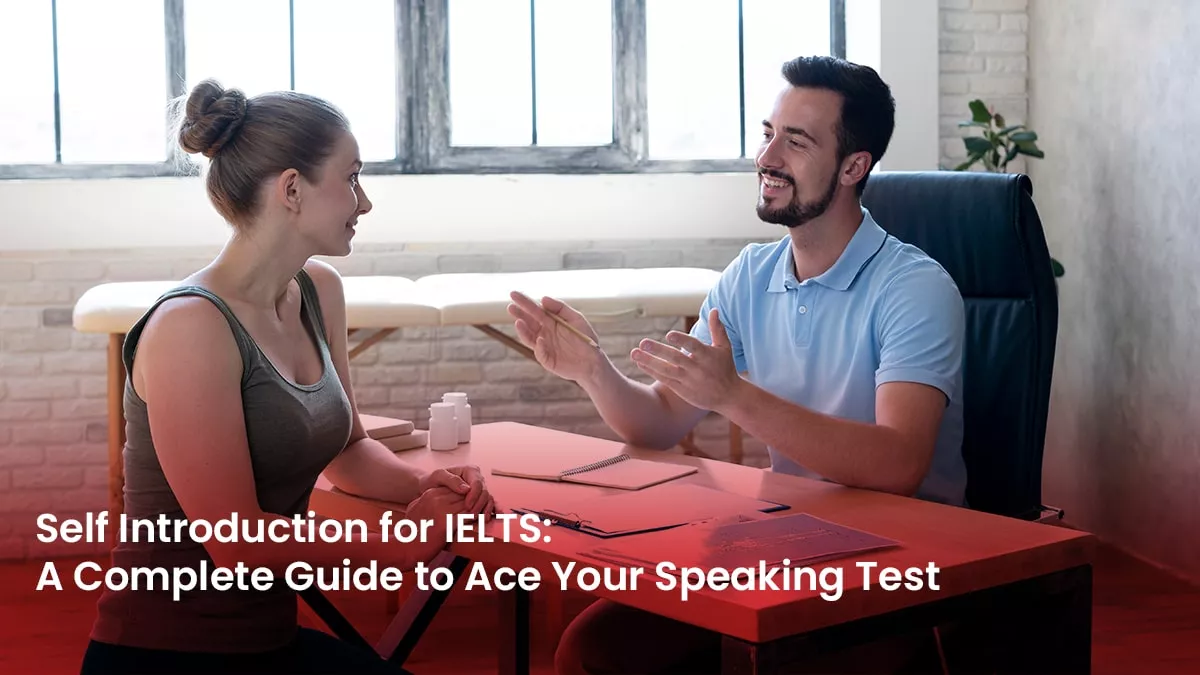The IELTS Speaking test starts with a self-introduction, which is your chance to make a great first impression. The self-introduction serves as an icebreaker, helping you settle into the conversation, but it also allows the examiner to assess your fluency, pronunciation, grammar, and vocabulary. Crafting a strong and natural self introduction for IELTS is vital to setting the right tone for the speaking test.
This blog will guide you through the process of creating an impactful self-introduction, provide sample responses, and offer tips for scoring high. Whether you are aiming for a band 7 or targeting the elusive IELTS self introduction band 9, this guide will equip you with the right tools to approach your self-introduction with confidence.
What is the self introduction in IELTS?
In the IELTS Speaking test, the first part consists of a brief self-introduction where the examiner asks you basic questions about yourself. You will be asked to introduce yourself, give information about your hometown, occupation or studies, hobbies, and possibly your reasons for taking the IELTS exam. This part typically lasts around 4-5 minutes.
The self-introduction might seem simple, but it’s a crucial element of the test. It’s your first chance to show off your English-speaking skills and ease into the conversation. The examiner wants to see how naturally and clearly you can communicate basic information about yourself.
How to give self introduction in IELTS exam
To give an effective self introduction for IELTS, follow these steps:
- Start with a polite greeting: Begin by greeting the examiner. You can say “Good morning” or “Good afternoon.”
- State your name clearly: Ensure that you speak confidently when saying your name.
- Mention your hometown: You can provide a brief description of your city or country.
- Talk about your occupation or studies: Depending on your situation, you can either mention your job or what you are studying.
- Discuss your hobbies or interests: Briefly mention your interests.
- Explain your reason for taking the IELTS exam (optional): You can include a sentence about why you are taking the test.
This structure will help you deliver a fluent, organized, and engaging self-introduction that covers all the essential information the examiner is looking for.
Self introduction IELTS example
To give you a better idea, here are two self introduction examples for IELTS:
Example 1:
“Good morning, my name is Lisa Chen. I’m from Beijing, the capital city of China. I recently graduated with a degree in Civil Engineering from Peking University. Currently, I’m preparing for my postgraduate studies abroad, which is why I’m taking the IELTS exam. In my spare time, I enjoy painting and playing the guitar.”
Example 2:
“Good afternoon, my name is Ahmed Hassan. I’m from Cairo, Egypt, where I work as a financial analyst. In my free time, I love reading about history and taking photographs. I’m planning to move to the UK for work, so I’m taking the IELTS to improve my English proficiency.”
These examples illustrate how you can introduce yourself smoothly and include relevant details without sounding rehearsed.
Tips and Tricks to Clear the IELTS Exam in the First Attempt
Key tips for the best self introduction for IELTS
- Be concise and clear: While it’s important to include essential details, don’t go into unnecessary depth. Aim to keep your introduction around 30-45 seconds.
- Practice pronunciation: Make sure that you pronounce every word clearly and confidently. Practicing in advance will help you improve your pronunciation.
- Expand your vocabulary: Use a variety of phrases to describe yourself. For instance, instead of always saying “I like,” try saying “I enjoy” or “I am passionate about.”
- Speak naturally: The examiner can tell if you’ve memorized your answers. Focus on being conversational rather than robotic.
- Maintain eye contact and smile: Showing confidence through body language is just as important as your words. A smile and good eye contact can help create a positive impression.
IELTS speaking part 1 self introduction questions and answers
Here are common IELTS speaking self introduction questions you might be asked during the test, along with sample answers:
- Can you tell me your full name?
Answer: “My full name is Emily Carter, but you can call me Emily.” - Where do you come from?
Answer: “I come from Tokyo, which is the largest city in Japan.” - What do you do?
Answer: “I am a high school teacher specializing in mathematics.” - Why are you taking the IELTS exam?
Answer: “I’m taking IELTS because I plan to study for my master’s degree in the United States.” - What do you do in your free time?
Answer: “In my free time, I enjoy playing tennis and cooking.”
These questions are designed to help the examiner get to know you better while assessing your basic conversational skills.
How to achieve IELTS self introduction band 9
If your goal is to achieve a band 9 in the IELTS Speaking test, you need to demonstrate mastery in the following areas:
- Fluency and coherence: Speak smoothly without unnecessary pauses. Practice transitioning from one point to another without hesitation.
- Wide range of vocabulary: Use advanced vocabulary and synonyms to avoid repetition. Show the examiner that you can express yourself in multiple ways.
- Grammar accuracy: Use a range of sentence structures, including complex and compound sentences. Ensure your grammar is error-free.
- Pronunciation: Speak clearly with correct intonation and stress on important words. Pronunciation plays a significant role in achieving a high band score.
Practicing your self-introduction regularly with these goals in mind will help you improve your speaking skills and aim for a higher band score.
Best self introduction for IELTS speaking: Dos and Don’ts
Dos:
- Do be clear and concise.
- Do make eye contact with the examiner.
- Do use varied vocabulary to avoid repetition.
- Do practice beforehand to improve fluency.
Don’ts:
- Don’t speak too fast or too slowly.
- Don’t give a rehearsed or memorized answer.
- Don’t overcomplicate your introduction with unnecessary details.
- Don’t worry if you make a small mistake – stay calm and continue.
Ways to Improve Your IELTS Score
Self introduction IELTS table
Here’s a quick table summarizing the key components of a great self-introduction:
| Component | Example |
| Greeting | “Good morning, my name is…” |
| Hometown | “I’m from Melbourne, Australia.” |
| Occupation/Studies | “I work as a teacher” or “I’m studying engineering.” |
| Hobbies | “In my free time, I enjoy reading and playing football.” |
| Reason for IELTS | “I’m taking IELTS to apply for a master’s program abroad.” |
By following this structure, you can confidently deliver an organized and effective self introduction for IELTS.
Conclusion
The self introduction for IELTS is an essential part of the IELTS Speaking test, and a well-prepared introduction can set the tone for a successful exam. By being clear, concise, and confident, you can make a positive first impression. Use the examples and tips outlined in this guide to craft your best self introduction and practice regularly to refine your delivery. With consistent practice, you’ll feel more at ease, and your performance will reflect your preparation.
MSM Unify overseas education consultant can help you prepare for the IELTS exam with expert guidance and resources. Start your IELTS journey today and move one step closer to achieving your academic or professional goals abroad!



























